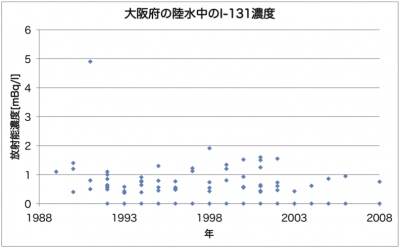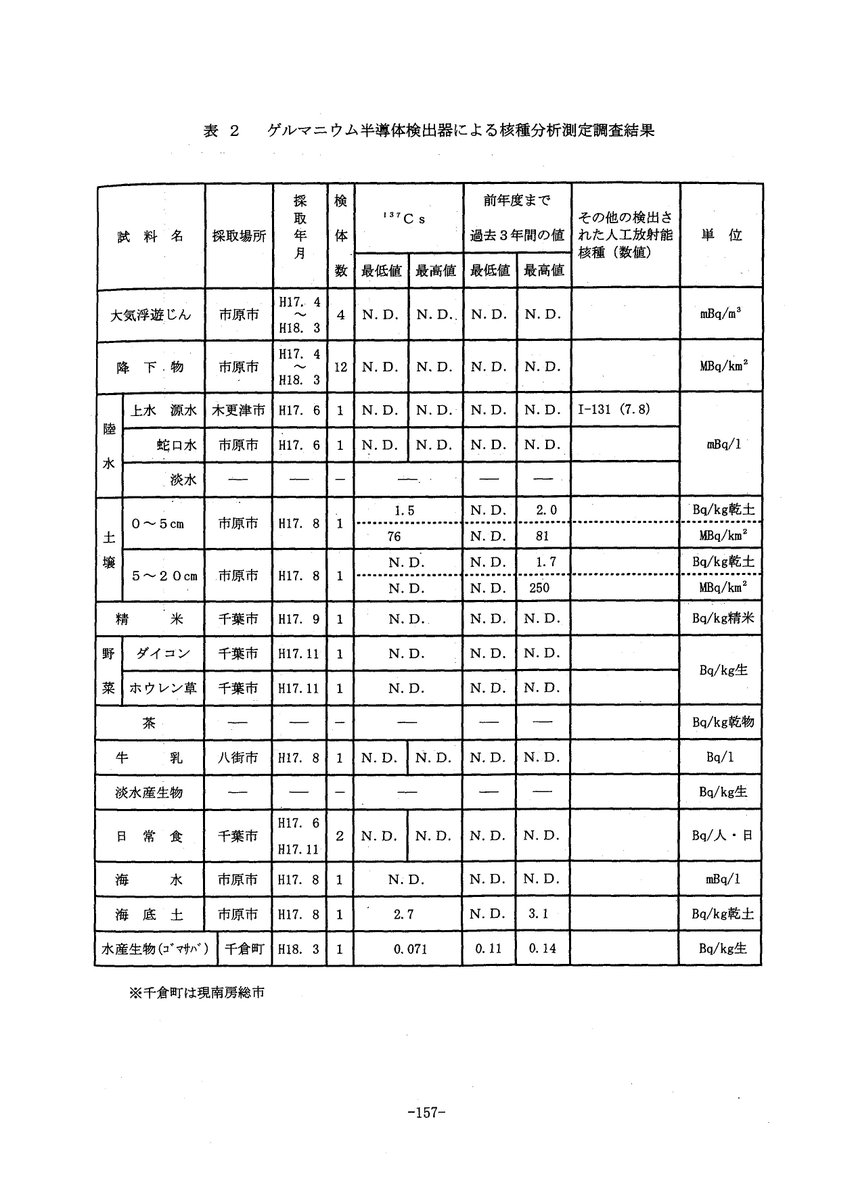患者に投与された放射性核種は下水処理場に集まらないのですか?
リスクは十分に小さい(=公衆の線量限度を確実に担保できる)ことが確認されています。

英国での検討結果
NRPB W-63 Radiological Assessments for Small Users
米国での検討結果
Toxic Substances Portal
IODINE
Iodine-131 in Sewage Sludge from a Small Water Pollution Control Plant Serving a Thyroid Cancer Treatment Facility
平成15年厚生労働省科学研究費補助金(医薬安全総合研究事業)
「医療行為に伴い排出される放射性廃棄物の適正管理に関する研究」
核医学施設における排水管理の合理的処理方法に関するガイドライン(案)
関連する研究発表
Volker Hormann and Helmut W. Fischer. A simple compartment model for the dynamical behaviour of medically-derived 131I in a municipal wastewater treatment plant
Preliminary Comparison of Radioisotope Helmut W.Fischer, Yoshiyuki Yokoo. Concentration in Sewage Sludge after the Fukushima and Chernobyl Accidents.
平成19年度全国衛生化学技術協議会
都市環境に放出される放射性医薬品のモニタリング
整理中
大気中に放出された医療系核種による公衆への電離放射線曝露量の推計
観測例
Detection of radioactive iodine at trace levels in Europe in January 2017
患者の居宅でも使えるかもしれない方法のアイデア例
排水設備周囲の線量率
Monte Carlo Calculation of External Dose Rate around a Radionuclide Reservoir Tank Using EGS4(pdf file, 520kB)
第44回 アイソトープ・放射線 研究発表会(2007年)
ポスター前半
ポスター後半
観測例Ge半導体検出器による観測例
流入水
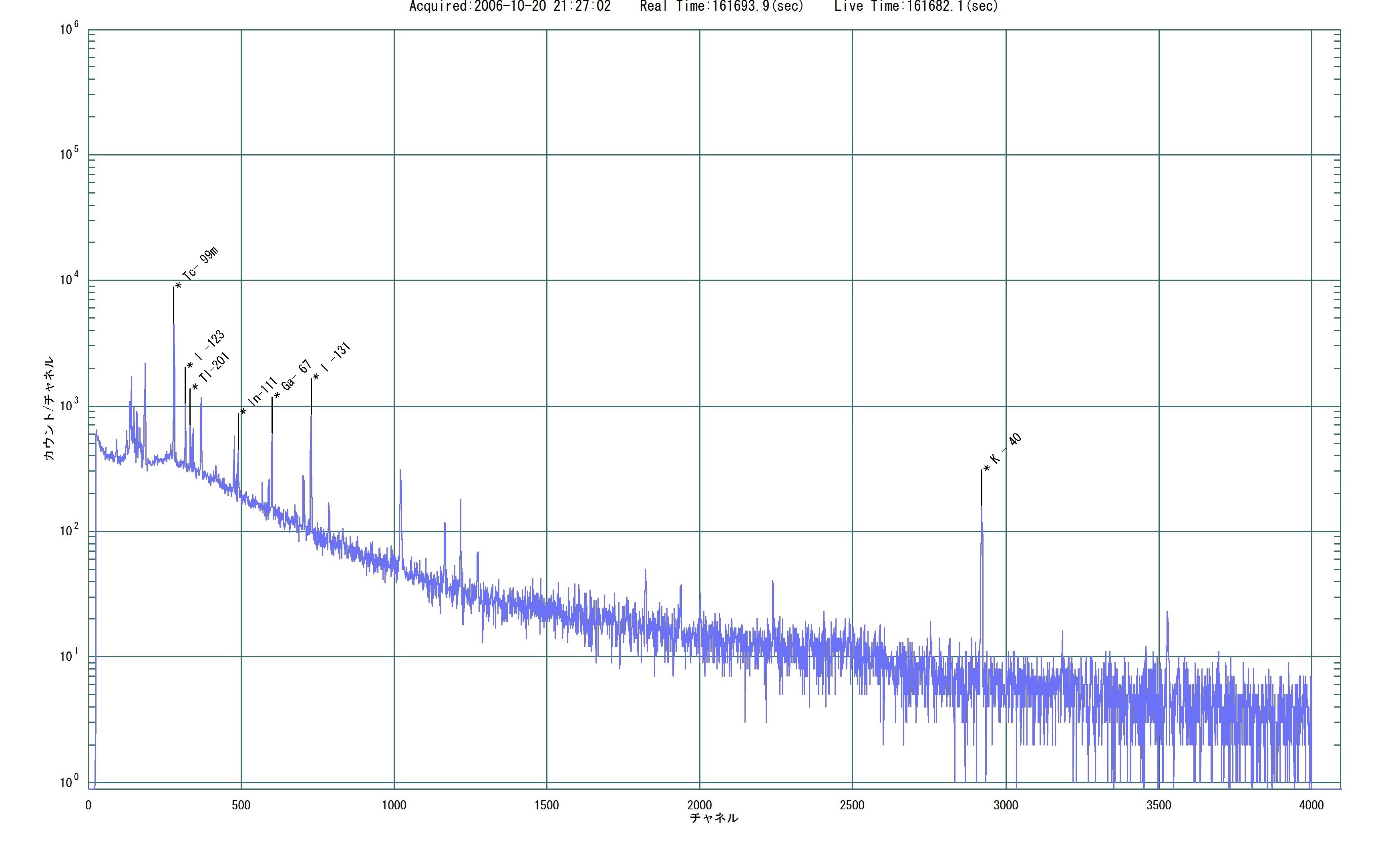
脱水汚泥
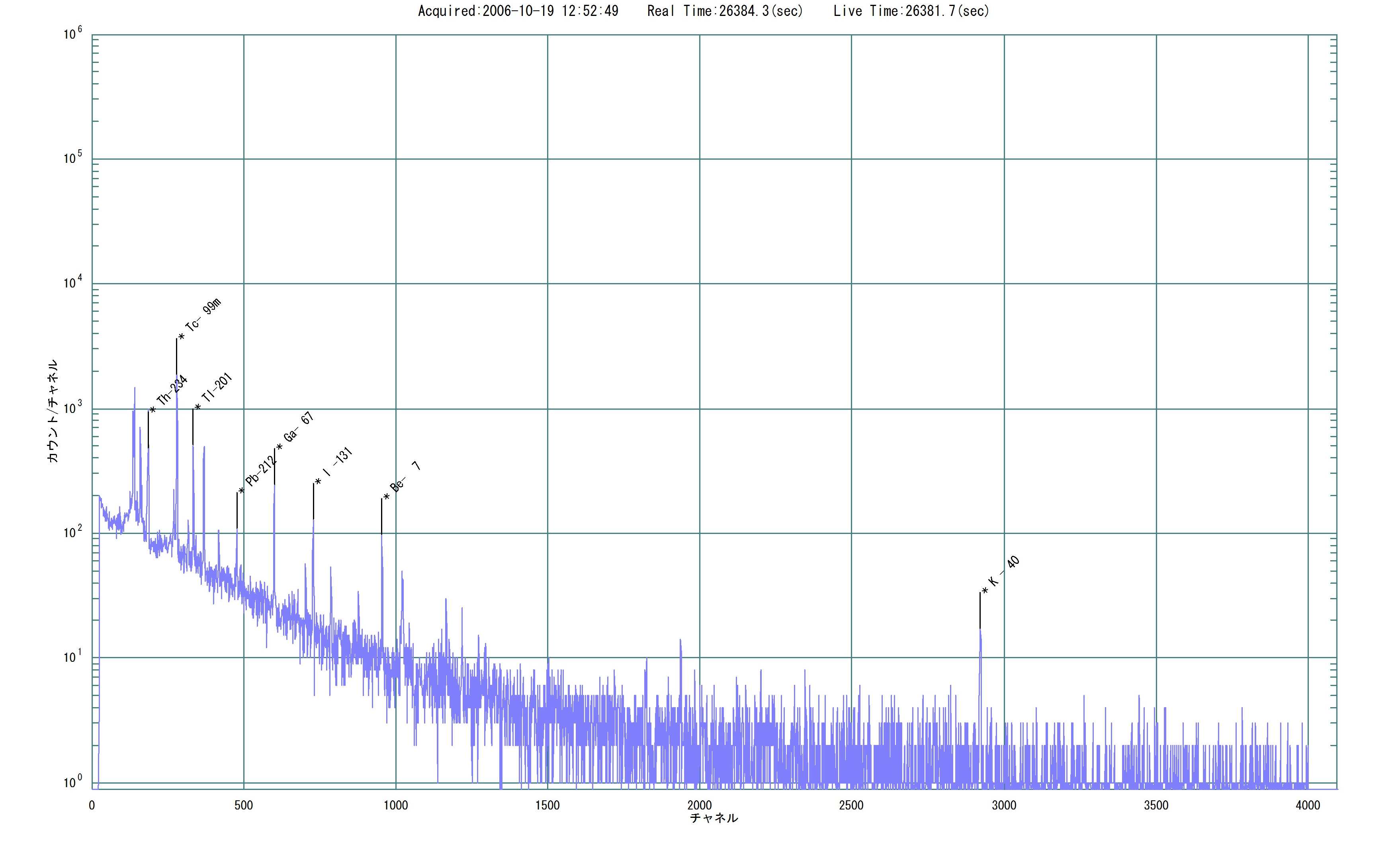
汚泥焼却灰
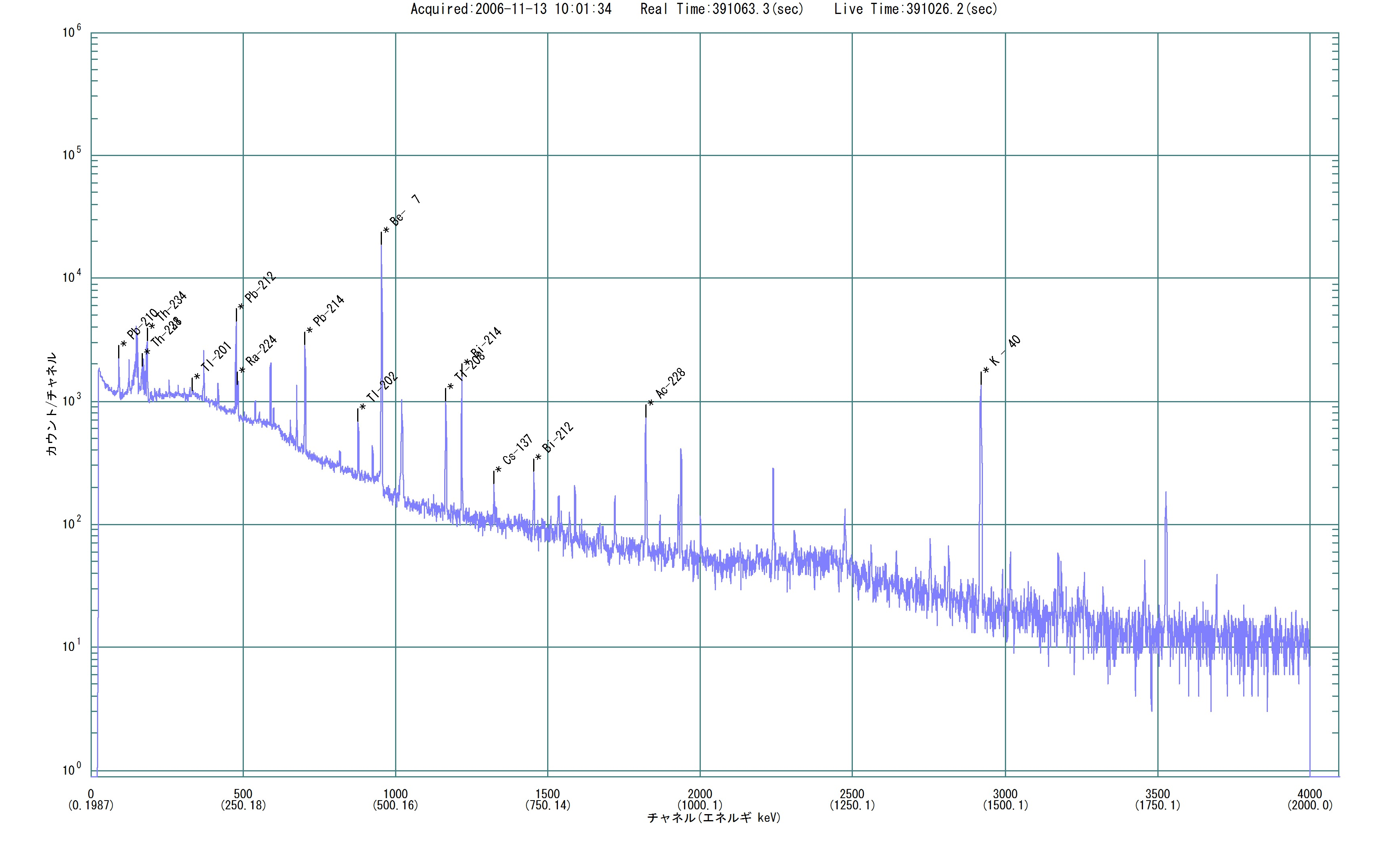
The Bremen State Radioactivity Measurements Laboratory
Radioactivity Measurements Laboratory
国土交通省
下水汚泥等の放射能濃度測定結果
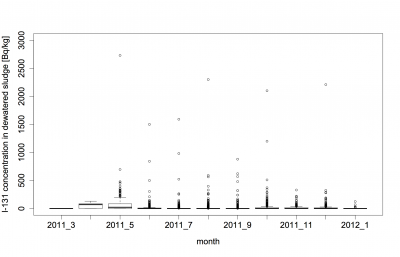
山梨県
(第3回)山梨県流域下水道汚泥中の放射性物質の調査結果について(速報)(pdf file, 57kB)
長野県松本市
下水道汚泥の検査結果について
市民団体から要望例
○下水汚泥から放射性ヨウ素が検出された場合は数値とともに福島原発由来のヨウ素でない等のコメントの掲載を検討していただけますか?
市民団体から質問例
2013年10月17日 上田市の下水汚泥から放射性ヨウ素が検出されたことに関連して、長野県内の医療施設の放射性ヨウ素の使用量等について長野県にお聞きしました。
山形県
下水汚泥中の放射性物質の測定結果について
下水汚泥中の放射性物質の測定結果
平成23年度から、本県が管理する4箇所の流域下水道の浄化センターから発生する下水汚泥に含まれる放射性物質の測定を行ってきましたが、近年は基準値より十分低い値で推移していることから、令和2年度をもって定期測定を終了することとしました。
今後は、新たな放射性物質の飛散があった場合などの異常時に測定を行います。
直近の測定結果
| 施設名 | 所在地 | 試料採取日 | 放射性ヨウ素
(ベクレル/kg) | セシウム134
(ベクレル/kg) | セシウム137
(ベクレル/kg) | セシウム合計
(ベクレル/kg) |
|---|
| 山形浄化センター | 天童市大町 | 令和2年8月5日 | 15 | 不検出
(<0.70) | 3.2 | 3.2 |
| 村山浄化センター | 村山市大久保 | 令和2年8月5日 | 42 | 不検出
(<0.46) | 2.5 | 2.5 |
| 置賜浄化センター | 南陽市宮崎 | 令和2年7月28日 | 不検出
(<0.79) | 不検出
(<0.70 | 不検出
(<0.97) | 不検出 |
| 庄内浄化センター | 庄内町家根合 | 令和2年8月5日 | 不検出
(<0.53) | 不検出
(<0.54) | 不検出
(<0.59) | 不検出 |
検査結果の括弧内は、検出下限値です。検出下限値とは、検査機器で測定できる最小の値のことであり、放射性物質の測定結果がこの数値未満である場合、「不検出」と表記します。
放射性ヨウ素が検出されている理由については、医療由来の放射性物質の影響が考えられます。放射性ヨウ素剤を用いた治療等を受けた方の尿などに含まれる放射性ヨウ素が、自宅のトイレなどから下水道に流入したものと推定されます。
日本下水道施設業協会
第7回公開講座「放射性廃棄物の観点からの下水汚泥処理処分の課題」
岩手県奥州市
公共下水道施設で発生する汚泥等の放射性物質濃度測定結果について
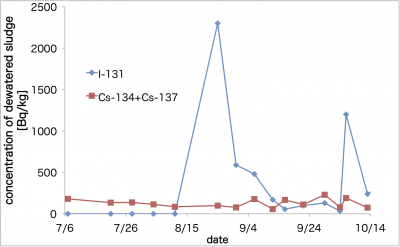
熊本市上下水道局
平成25年2月の測定で城南町浄化センターの下水汚泥から4,500Bq/kgの放射性ヨウ素131が検出されていますが、これを1時間あたりの外部被ばく線量に換算すると0.00028μSv/hとなり、熊本県の環境放射能水準調査における過去の大気中の平常時の値(0.021μSv/h~0.067μSv/h)よりはるかに少ない値です。(中略)放射性ヨウ素については、文部科学省の環境放射能調査研究成果論文、他都市の調査結果、日本医学放射線学会等の「放射性ヨウ化(I-131)ナトリウムカプセルを用いた内用療法の適正使用マニュアル」などによると、がん治療などの医療目的に使用された放射性ヨウ素が患者の体内から排出され、下水に流入したことが原因ではないかと考えられます。
内部被ばくのリスクも推計できます。
長崎市上下水道局
510 ベクレルの放射性ヨウ素から受ける放射線を年間の外部被ばく線量に換算すると、0.0002 ミリシーベルトに相当します。宇宙からの放射線等など自然界から被曝している線量は、日本の年間平均は 1.5 ミリシーベルトとされていることから、今回検出された放射線濃度は問題ないものです。
計算根拠は示されていないようですが、510 BqのI-131を乳児が経口摂取したとすると、線量換算係数として、1.40E-04mSv/Bqを用いると7.14E-02 mSvの預託実効線量となります。
清掃工場での集積例
東京二十三区清掃一部事務組合
飛灰の放射能濃度測定結果例
清掃関係業界への配慮の必要性に言及している例
絹谷 清剛.アイソトープ内用療法の現状と将来のために考えるべきこと
原子力発電所事故との関連記事
原子力発電所内のI-131
懸念表明例
放射性ヨウ素、いま東京で検出のナゼ????(その2)
RI治療病床の確保に関して議論している例
RI 内用療法の将来展望と提言
トレーサとしての活用例
Medically-Derived 131I as a Tool for Investigating the Fate of Wastewater Nitrogen in Aquatic Environments
医療機関の放射線管理への疑念が表明されている例
排水時では試料を減衰させて測って、その結果放射性物質がないと説明しているのではないか?
第105回女川原子力発電所環境保全監視協議会会議録
例えば半減期8日という話も女川町議会においても出ましたが、半減期を越してから測定してるのではないかというような話まで出るわけです。そういうことではないという話はしておりますが、理屈を立てるとそういうことになってきます。ですから、どこに原因があるのかという我々の対応というのは非常に難しいものです。
試料採取日時と測定日時は記録されており、試料が減衰した後に計測してなかったことにすることはできません。
様々な資料
Management of radioactive waste from the use of radionuclides in medicine
An overview of radioactive waste disposal procedures of a nuclear medicine department
EPA. A Regulators’ Guide to the Management of Radioactive Residuals from Drinking Water Treatment Technologies
GROUNDWATER INFORMATION SHEET Radionuclides
NUCLEAR REGULATION:Action Needed to Control Radioactive Contamination at Sewage Treatment Plants
トレーサーとしての活用例
RADIOACTIVE RESIDUES ASSOCIATED WITH WATER TREATMENT
Liquid Scintillation Counting Methodology for 99Tc Analysis: A Remedy for Radiopharmaceutical Waste
Volume 1: Task 2.1 Report Radiological Risk Assessment for King County Wastewater Treatment Division
Output of radiopharmaceutical nuclides of known injected doses from a municipal sewage treatment system.
環境負荷の軽減
診療用放射性薬剤の拡散前トラップ手法の開発
環状オリゴ糖を用いた新しい放射性ヨウ素回収・保持システム開発に向けた基礎的研究
要望例
Lu-177
放射性医薬品の投与患者の退出基準の緩和
医療機関から排出される廃棄物の下水処理への影響への懸念例
都内医療機関における医療廃棄物処理の実態調査 ~医療廃棄物の適正処理のために~
A STUDY OF EFFLUENT CONTROL TECHNOLOGIES EMPLOYED BY RADIOPHARMACEUTICAL USERS AND SUPPLIERS
Analysis of air discharges from a radiopharmaceutical production center based on a cyclotron
Medical radioisotopes in the environment – following the pathway from patient to river sediment
Design of patient rooms and automatic radioiodine-131 waste water management system for a thyroid cancer treatment ward: ‘Suandok model’
Radioactive Waste Management in A Hospital
衛生労働者の健康問題
WHO
New report exposes horror of working conditions for millions of sanitation workers in the developing world
Health, safety and dignity of sanitation workersAn initial assessment
規制
§ 20.2003 Disposal by release into sanitary sewerage.
(a) A licensee may discharge licensed material into sanitary sewerage if each of the following conditions is satisfied:
(1) The material is readily soluble (or is readily dispersible biological material) in water; and
(2) The quantity of licensed or other radioactive material that the licensee releases into the sewer in 1 month divided by the average monthly volume of water released into the sewer by the licensee does not exceed the concentration listed in table 3 of appendix B to part 20; and
(3) If more than one radionuclide is released, the following conditions must also be satisfied:
(i) The licensee shall determine the fraction of the limit in table 3 of appendix B to part 20 represented by discharges into sanitary sewerage by dividing the actual monthly average concentration of each radionuclide released by the licensee into the sewer by the concentration of that radionuclide listed in table 3 of appendix B to part 20; and
(ii) The sum of the fractions for each radionuclide required by paragraph (a)(3)(i) of this section does not exceed unity; and
(4) The total quantity of licensed and other radioactive material that the licensee releases into the sanitary sewerage system in a year does not exceed 5 curies (185 GBq) of hydrogen-3, 1 curie (37 GBq) of carbon-14, and 1 curie (37 GBq) of all other radioactive materials combined.
(b) Excreta from individuals undergoing medical diagnosis or therapy with radioactive material are not subject to the limitations contained in paragraph (a) of this section.
ピットホール例
排水管内でのRIの滞留
For Ablative I-131 therapy, is there a well known/established value for the percentage of I-131 that adheres to pipes after patient excretion?
下水処理場でのモニタリング
11 都市下水の放射能調査(Ⅰ)ヨウ素 – 北海道立衛生研究所
千坂 治雄, 鈴木 隆司, 岡野 安宏, 猪越 幸雄, 堀口 泰裕, 山本 龍夫, 都市排水中放射能のin situ測定, RADIOISOTOPES, 1979, 28 巻, 6 号, p. 374-376.
千坂 治雄, 鈴木 隆司, 猪越 幸雄, 岡野 安宏, 堀口 泰裕, 山本 龍夫, 都市排水中の放射能, 保健物理, 1982, 17 巻, 4 号, p. 521-526.
鈴木 隆司, 岡野 安宏, 杉浦 城春, 猪越 幸雄, 下水汚泥中に含まれる核医学で使用されている核種の放射能濃度及び被曝線量評価, 保健物理, 1998, 33 巻, 2 号, p. 163-170.
Nakamura, Ayako*; Hayabuchi, Naofumi*; Osaki, Tomoe†; Osaki, Susumu‡. OUTPUT OF RADIOPHARMACEUTICAL NUCLIDES OF KNOWN INJECTED DOSES FROM A MUNICIPAL SEWAGE TREATMENT SYSTEM. Health Physics 88(2):p 163-168, February 2005. | DOI: 10.1097/01.HP.0000144577.34056.98
中村 綾子, 大崎 進, 早渕 尚文, 都市下水処理システムにおける核医学で使用した放射性核種の動向, RADIOISOTOPES, 2001, 50 巻, 8 号, p. 343-352.
How sewage could reveal true scale of coronavirus outbreak
三浦 尚之, 風間 しのぶ, 今田 義光, 真砂 佳史, 当广 謙太郎, 真中 太佳史, 劉 暁芳, 斉藤 繭子, 押谷 仁, 大村 達夫.感染性胃腸炎流行の早期検知を目的とした下水中ノロウイルスモニタリングの有用性
造影剤
MRI造影検査後に尿中排泄された造影剤はどこにいく?
医療機関の排水設備
病院における排水設備
浄化槽の管理
浄化槽リノベーション推進検討会
浄化槽管理者への設置と維持管理に関する指導・助言マニュアル
建築物の用途別による屎尿浄化槽の処理 対象人員算定基準(JIS A 3302-2000) Estimation of population for waste water purifier of buildings
小関 聡恵((一社)浄化槽システム協会講師団).RI(放射性同位元素)排水処理と浄化槽(月刊浄化槽 2020年9月号)
RI(放射性同位元素)排水処理と浄化槽
坂元 幹夫.ラジオアイソトープ処理施設の施工報告. 西松建設技報 VOL.24
下水疫学調査
WHO. Environmental surveillance for SARS-CoV-2 to complement other public health surveillance
北島 正章,原本 英司.下水中の新型コロナウイルスの分析
東 剛志, 菅原 民枝, 中田 典秀, 山下 尚之, 三野 芳紀, 田中 宏明, 大日 康史, 下水中の抗インフルエンザ薬成分を用いた疫学調査手法の検討, 環境技術, 2014, 43 巻, 4 号, p. 226-232
Nattino G, Castiglioni S, Cereda D, et al. Association Between SARS-CoV-2 Viral Load in Wastewater and Reported Cases, Hospitalizations, and Vaccinations in Milan, March 2020 to November 2021. JAMA. Published online April 01, 2022. doi:10.1001/jama.2022.4908
JSRT
核医学部会RI内用療法班
[お知らせ]核医学治療の適正使用における実態調査アンケートのお願い
I-125シード線源での事例
Event Notification Report for January 01, 2019
During the search of the missing I-125 seed on December 13, 2018, licensee staff surveyed the surgical suite and recovery room of the patient. The licensee staff were not able to find the missing seed. During the survey, licensee staff also questioned the nursing staff and it was noted that a nurse emptied a catheter bag into a toilet shortly following the completion of surgery. Licensee staff believe that the missing I-125 seed may have been flushed and disposed in the sanitary sewage system.
IAEA
IAEA-TECDOC-1040 Design and implementation of a radiotherapy programme: Clinical, medical physics, radiationprotection and safety aspects
Procedures which are unique to LDR sources are:
g) If the source storage and preparation room is also the applicator loading room, there should be a sink for cleaning of the applicators. However, a sink can also lead to a loss of sources to the sewerage when inadvertently a source is left in the applicator or a patient
観察された現象に関して科学的に説明すべきとの議論例
2012年2月17日 第6回水道水における放射性物質対策検討会議事録
公共下水関係でも核医学治療に用いる核種だけでなく診断領域の核種も容易に検出されることがあります。
記事作成日:2010/04/01 最終更新日: 2024/01/24
